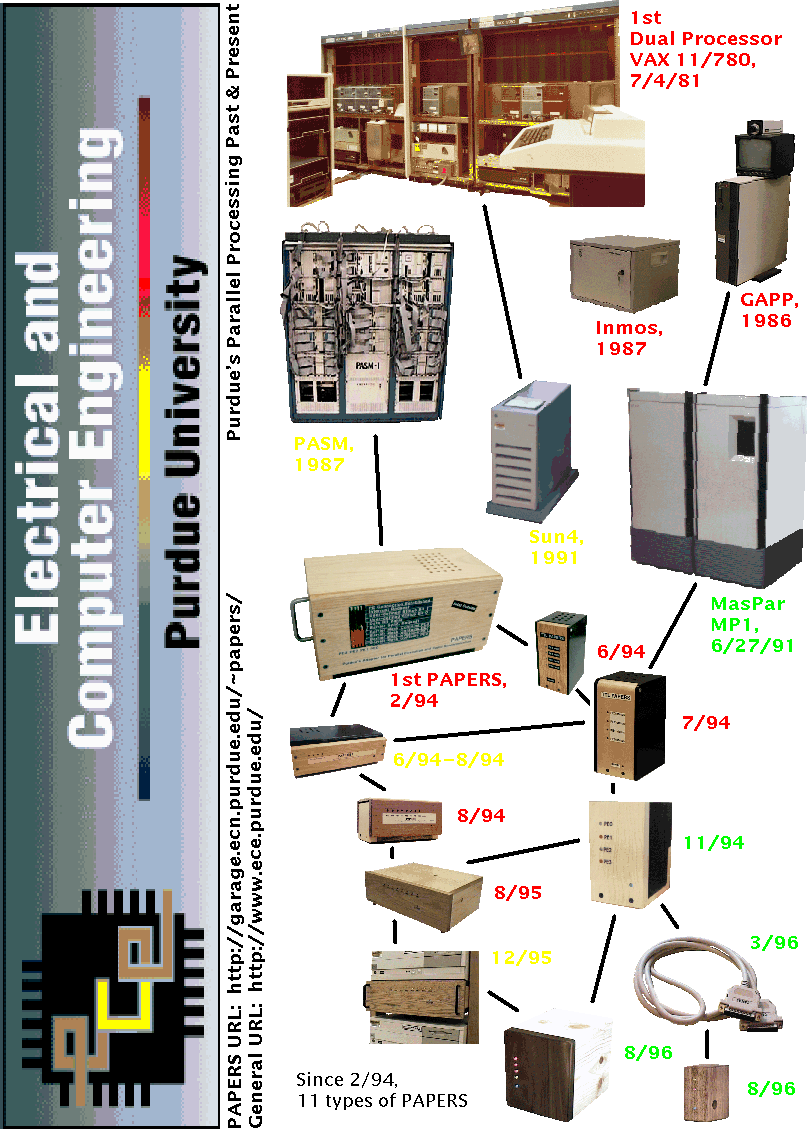Purdue's Parallel Processing Past & Present
School of Electrical and Computer Engineering
Purdue University
West Lafayette, IN 47907-1285
Parallel processing is the key to dramatic speed increases for
supercomputing tasks, but that doesn't mean that it is easy to achieve
speedup using parallelism. At the Purdue University School of
Electrical and Computer Engineering, we long ago realized that the
best speedup will only be obtained through careful design and
implementation of the parallel computing system -- integrating both
hardware and software to maximize system performance. It is perhaps
easiest to see the evolution of these ideas through the sampling given
in the graphical timeline, coupled with the
following brief descriptions:
-
1st Dual Processor VAX 11/780 & Sun4.
-
In 1981, DEC VAX 11/780 machines running UNIX were the mainstream
computing support for many schools around the country... but they
were not sufficient for the needs of Purdue Electrical Engineering.
For this reason, George Goble and Mike Marsh sought a low-cost way to
multiply the processing power -- which they did by discovering a way
to add a second 11/780 processor to a standard uniprocessor system.
Further, BSD UNIX was modified to support this dual-processor
configuration, thus creating the first multiprocessor UNIX
system (see http://ghg.ecn.purdue.edu/vax/paper.html). Not only were many
such systems configured at Purdue, but the hardware and software were
widely adopted and adapted. The 4 PE Sun4 system was an early
commercial version of SMP UNIX technology. Beyond using such systems,
Purdue is also involved with the development of SMP Linux for parallel
processing applications (see http://yara.ecn.purdue.edu/~pplinux/).
-
Inmos Transputers.
-
The 16 PE Inmos Transputer system served as a training ground for
learning about message-passing MIMD systems. Since then, Purdue has
purchased nCUBE, nCUBE2, Intel Paragon XPS, and IBM SP2 message-passing
MIMD systems as general-use supercomputers.
-
NCR GAPP & MasPar MP1.
-
The NCR GAPP is a SIMD system built using an array of 48x48 bit-serial
processors equipped with a video input; it was used primarily by Jose
Fortes as a target for compiler code scheduling and algorithm mapping
research. The GAPP also increased our interest and understanding of
massively-parallel SIMD, leading to the purchase of a 16,384 PE MasPar
MP1 (the first maximum-configuration system in a US university). The
MP1 still serves as a general-use supercomputer, but also was the
focus of a wide range of hardware and system software research
including Hank Dietz's development of compiler technology that allows
a SIMD machine to efficiently execute MIMD programs.
-
PASM.
-
PASM is the Partitionable SIMD MIMD experimental
system designed by H. J. Siegel's research group. There are a number
of innovations in this prototype system which was entirely built at
Purdue; for example, PASM incorporates a parallel mass storage system
and the patented "Extra Stage Cube" network, but perhaps the most
significant contribution is the concept of building a machine that can
execute in either SIMD or MIMD modes yet uses commodity processors.
PASM is capable of being partitioned into up to four submachines, each
of which can switch between SIMD and MIMD modes in just a few
instructions, thus allowing the mode best matching each portion of a
parallel algorithm to be used. This work has since expanded to manage
the use of heterogeneous groups of parallel supercomputers.
-
PAPERS.
-
After building PASM, we realized that the implementation "trick" that
allowed the machine to execute both SIMD and MIMD using commodity
processors was really a barrier synchronization mechanism that could
be invoked at each instruction fetch. This led Hank Dietz and his
students to further study the architecture, implementation, and
associated compiler technology for barrier synchronization. Major
progress was made in developing compiler technology and SIMD/VLIW/MIMD
mode emulation, as well as classification of two types of fully
partitionable barrier mechanism: SBM and DBM (Static and
Dynamic Barrier MIMD). Limited SBMs were built
(e.g., PASM and Thinking Machines CM5), but the complexity of the
architecture deterred implementation of a DBM until late in 1993, when
we discovered a way to build a DBM using n SBM barrier
units and a special 1-bit wide multibroadcast network. PAPERS,
Purdue's Adapter for Parallel Execution
and Rapid Synchronization, began as a proof-of-concept
DBM implementation... but we soon discovered that having a simple
stand-alone DBM or SBM unit that could use unmodified PCs or
workstations as PEs was a very significant advance toward making
parallel processing available to the masses. We also discovered a new
communication model in which a single communication operation can
compute an Aggregate Function of the data collected from
all PEs, essentially an extension of the concept of the MasPar
MP1's "global Or" network. Nearly all aspects of the PAPERS project
are available on-line at http://garage.ecn.purdue.edu/~papers/.
The above descriptions, and the photos on the reverse side, are only a
small sampling of the work and facilities at Purdue's School of
Electrical and Computer Engineering. The school has approximately 70
faculty, 1,000 undergraduate students, and 500 graduate students. To
make things fit this page, we have omitted mention of the work
involving parallelizing compilers, image and speech understanding, and
various engineering-oriented applications. For more general
information on the school, see: http://www.ece.purdue.edu/.


This page was last modified
.